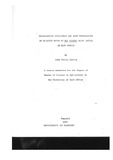| dc.description.abstract | Herds of Friesian and Jersey dairy cattle in
three climatically contrasting regions of East Africa
were involved; Njoro, in the Kenya Rift Valley; Kampala,
to the north of Lake Victoria in Uganda; and Mombasa, on
the Indian Ocean. All locations were close to the
A equator. Differences in climate resulted from the
variations in altitude.
An analysis vas made of the herd records, but vas
limited in ~cope as a result of the small number of
records available, particularly at the Lake and Coast.
Differences in milk yield between the Jersey herds were
small. There vas a noticeable fall from the Rift through
to the Coast in the Friesian yields. Corrections for the
effect of high ambient temperature rendered the three
herds similar. Calving interval ranged from a mean of
381 to 439 days, with no marked differences .between
locations.
The Rift herds shoved highly significant (P<O.Ol)
positive correlations between current 305-day lactation
yield and current calving interval (r = 0.80 and '0.92).
Coefficients vere also positive at the other locations
d by 12 days (r = 0.68, P(O.Ol).
By plotting the monthly variations in calving
frequency at each location, it appeared that a greater
percentage of conceptions occurred during the rainy seasons,
despite the practice of year-round calving policy.
For the 40 cows under experiment in each herd,
there tended to be a gradation in reproductive efficiency
(time to first observable oestrus, oestrous cycle regularity,
service period and non-return rate) from the temperate
'control' (Rift) through to the Lake. It was very
noticeable that in certain cases, despite the very hot,
humid conditions, the Coast herds suffered less reproductive
disturbance than those at the Lake. There was little
difference in overall fertility between the .two breeds.
The effect of weather upon body temperature was
measured using a Temperature Humidity Index~
T.B.I. = 0.4 (Td + Tw) + 15
where Td = dry bulb temperature in degrees Farenheit,
and Tw = wet bulb temperature in degrees Farenheit.
Time and afternoon rectal temperature were highly
significant at the Coast (P(O.OOl). Temperatures rose
o 0
by 0.22 F and 0.25 F per unit rise in T.H.I. for the two
herds. Indices were invariably between 76 and 82. With
the rise in altitude, T.H.I. decreased at the Lake and
Rift and so also did the extent of body temperature
elevation. Previous reports from climate control chambers
indicated that 74 is the crucial Index, below which cattle
remain in their neutral zone and above which body
temperature tends towards the upper critical level. This
was found to be the case for the Lake herds, temperature
o
rising 1.00 and 0.83 F for each unit increase in T.H.I.
above 74.
Large diurnal fluctuations in body temperature
occurred at all locations, whatever the night-time T.H.I.
Lack of insolation at the Coast obviously provided a great
deal of relief, as also did shade during the day.
Temperature variations during the oestrous cycle
followed a typical low-high-low pattern over oestrus itself
with a gradual rise as the luteal phase progressed. The
curves were successively flatter from the Rift to the Coast.
Contrary to suggestions in the literature, level of
milk yield had no significant effect upon body temperature
at the Lake or Coast. At the Rift however, high yielding
cattle actually had significantly lover rectal temperatures.
Rectal temperature measured at a depth of 18 cm was
0.570F higher than that at 10 cm (P<O.OOl).
There were no differences in rectal temperature for
the first 15 days following successful and unsuccessful
services for the Rift herds. At the Lake and Coast,
unsuccessful services had significantly higher temperatures
over the 4 - 10 day period (levels of significance varied
between 0.4 - 0.01 per cent). This is consistent with
reports in the literature for cattle, sheep and the smaller
laboratory mammals.
It was not possible to determine the precise
elevation of body temperature at which embryo failure might
have occurred, but it was probably in the region of 103.0o
103.5 F.
It would appear that adaptation played an important
role in maintaining the reproductive efficiency of the
Coast herds at a level comparable with that of the Rift.
Correlations between T.H.I. at 1500 hrs East African | en |

